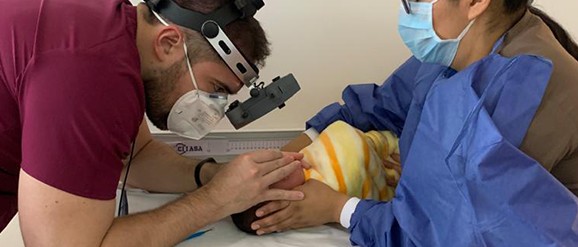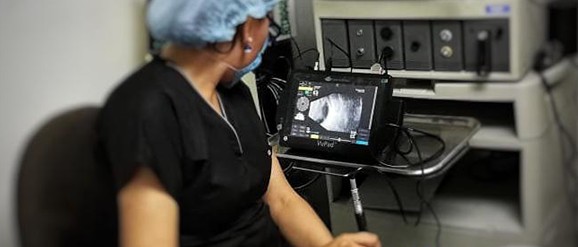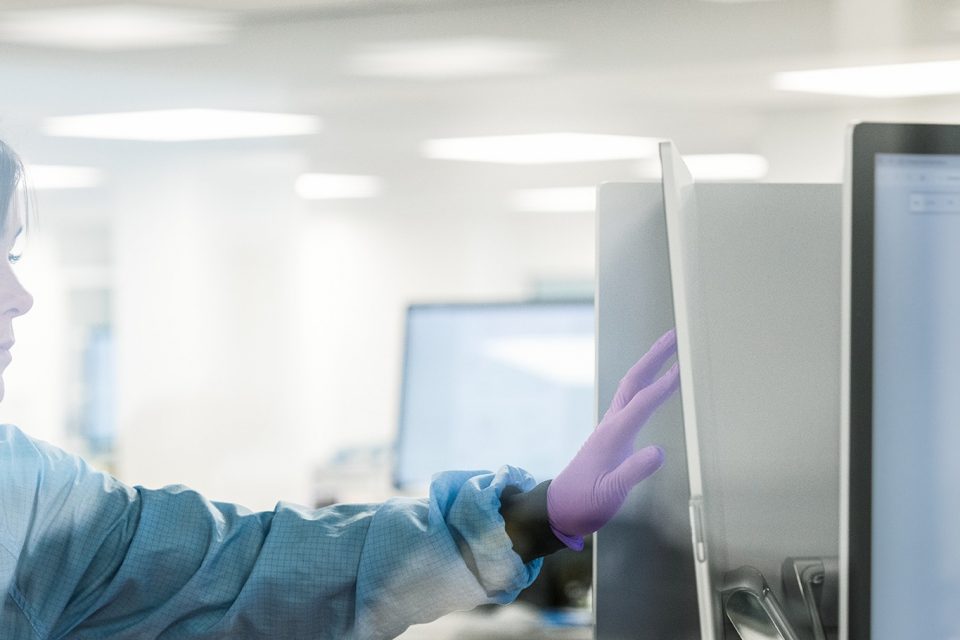With the support of Microsoft Philantropies, the Association to Prevent Blindness in Mexico, Hospital “Luis Sánchez Bulnes” I.A.P. (APEC), Business Data Evolution, and their partner organizations have developed an algorithm based on Microsoft’s AI to detect blindness in premature babies by capturing an image of the fundus with a mobile phone. The algorithm can predict the condition in a few seconds, and is 85% effective, compared to 60% if conducted by humans.
Today, the use of technology in different medical fields has transformed and optimized processes for the welfare of the population. Health cannot escape that reality, and it is also benefitting from new digital solutions. An example of this is the work of the Association to Prevent Blindness in Mexico, Hospital “Luis Sánchez Bulnes” I.A.P. (APEC), whose mission is to provide ophthalmic care to low-income patients.
APEC worked with Business Data Evolution and various Latin American organizations to develop a project that uses Azure’s Artificial Intelligence (AI) to determine Retinopathy of Prematurity (ROP) in time and, consequently, prevents blindness in premature babies.
Artificial Intelligence for timely diagnostics
Ophthalmologist and Pediatric Retina Specialist Dr. María Ana Martínez-Castellanos, the specialist who heads this altruistic project, points out that, in Mexico, 12 children a day lose their vision due to RoP. One of the main causes of blindness in children is the lack of resources for an early diagnosis of the condition, especially since such detection must be made in the first few weeks of a newborn’s life.
Unfortunately, in Mexico and in many Latin American countries, citizens lack access to a routine ophthalmic exam, much less treatment. “For this reason, children suffer damage to their vision. In Mexico, around 80% of hospitals lack the equipment and supplies to treat this condition, this is why we are affected by blindness in such large numbers,” explain the physician.
Dr. Martínez-Castellanos asserts that her goal and that of her colleagues is to ensure that the disease is diagnosed in time so that it can be cured. As of the first quarter of 2019, Dr. Martínez-Castellanos, along with a group of professionals from Mexico, Colombia and Argentina —all experts in RoP and AI— took on the challenge of creating an AI algorithm capable of recognizing possible cases of blindness in young eyes, and thus allowing for an optimized prevention and treatment plan.
To achieve this, APEC and its partner organizations enlisted the support of Microsoft Philanthropies through the AI for Health program. Microsoft Philanthropies gave the associations free access to Microsoft Cloud, the company’s cloud platform that includes data services, devices and applications. With this, APEC tapped into Azure’s simulation services to create its artificial intelligence solution.

An algorithm based on Microsoft Azure
The main component of the solution being developed by APEC, through Microsoft Cloud, is the deep neural network algorithm based on Machine Learning, previously trained for RoP diagnosis. Engineer Carlos Serafin, Business Data Evolution’s General Manager, explains: “We used Transfer Learning in a previously trained deep convolutional neural system. Along the way, we collected around 3,000 photographs and specialists helped us sort them into sick and healthy eyes.” Then, Azure’s Artificial Intelligence uses the collected images to train the algorithm to recognize common patterns among diseased eyes, as compared to healthy eyes.
The process includes a series of steps to evaluate the algorithm’s reliability indexes. “The first step involved collecting the photographs, the second, training the algorithm, and the third step focuses on validating it with never-before-seen photos, as well as verifying its accuracy indexes,” which according to Serafin are above 85%, compared to 60% when completed by humans.
Serafin highlights that through Microsoft Azure’s solutions, such as Blob Storage, Cognitive Services and virtual machines, the algorithm works as an emulator of the human eye. “Those neural networks have learned to distinguish colors, lines, edges,” explains Serafin. In addition, he adds that a global web service was installed in the algorithm’s neural network to upload the photos and be able to obtain the probability of the presence of RoP in real time. Likewise, with this solution, a second image is captured that reveals the retina’s affected area, which the tool identifies as diseased.

A mobile app to detect cases
The second component of the solution that is being developed by APEC and Business Data Evolution, also on Microsoft Azure, is a mobile phone app. The app will allow specialists to take a picture of a baby’s eyes from their cell phones. The image will be automatically sent to the web service and processed with APEC’s AI algorithm.
Serafin points out that the technical objective of the app is to make it possible for an ophthalmologist to obtain the detail of the baby’s retina with his or her mobile phone using a special lens, which costs $200 —instead of having to use a RetCam camera, a specialized digital device for pediatric ophthalmology that captures images of the fundus of premature babies but costs above $10,000. Then, by using the algorithm, the app lets the user know, in a matter of seconds, whether or not the child suffers from RoP.
In Mexico and in large parts of Latin America, access to quality health care is precarious. With these solutions, APEC, Business Data Evolution, and their partner organizations are on their way to democratizing health. This transformation towards digital is a first step to prove that technology is at the service of health. In addition, it serves as an example to push the rest of the organizations to apply this same initiative, so that all patients can have access to high-level medical care.
For Dr. Martínez-Castellanos and her team, another of the project’s main goals is for everyone to have access to high-performance technologies, such as Azure’s. She points out that it is highly feasible to support this type of initiative, and adds that covering the expenses of a blind person is a high cost proposition. “We are certain that, in Mexico, each blind person, annually, costs our country 1 million pesos. That is way more than it would be worth supporting this program and this type of technology.” For this reason, she has created a network of ophthalmologists with the aim of forming a team of professionals who have the responsibility and willingness to train other doctors.
Democratizing AI in the health sector
APEC took its first step towards the technological transformation and democratization of AI in the country’s healthcare sector with the purpose of improving —and saving— lives in Mexico and throughout Latin America. This innovation will go beyond the rapid and inexpensive detection of RoP: it will help to better prepare future professionals in this field of medicine. APEC hopes that ophthalmology students will have at their disposal a model platform based on Microsoft technologies for their training and academic practices.
For their part, the members of the APEC team explain that their goal is to promote this project in international medical conventions, in order for other countries to implement the use of AI solutions to save children’s vision in the region and around the world. “This case is very relevant. The more exposure, the more people will be interested in applying what we have learned,” explains Dr. María Ana Martínez-Castellanos. “If this program helps prevent blindness in just one child, it’s already worth it,” she concludes.
The AI algorithm and the mobile app developed as part of the described initiative was a joint effort by the following organizations: Clínica Oftalmológica Peñaranda (Colombia), Red RoP de la Provincia de Buenos Aires (Argentina), Centro Integral de Salud Visual Daponte ( Argentina), Hospital Italiano de Buenos Aires (Argentina), Clínica de Alta Especialidad Visual (Mexico), Association to Avoid Blindness (Mexico), Business Data Evolution (Mexico).
“If this program helps prevent blindness in just one child, it’s already been worth it.”
María Ana Martínez-Castellanos: Pediatric Retina Specialist
APEC




